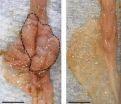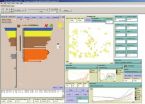(Press-News.org) The HPV vaccine offers significant protection against cervical abnormalities in young women, suggests a paper published on bmj.com today.
The human papillomavirus (HPV) can cause warts, with some strains causing cervical cancer.
Australia was the first country to implement a publicly funded national vaccination programme in April 2007 and a 'catch-up' programme that ran until December 2009.
Studies have shown that the two HPV vaccines used to vaccinate young women prevent cervical lesions associated with HPV types including vulval and vaginal lesions and genital warts in women as well as genital warts and high grade anal disease in men.
While clinical trials have demonstrated the effectiveness of the vaccine, little is known about the vaccine's effectiveness when delivered to a broader population. Researchers from Australia therefore looked to measure the effectiveness of the HPV vaccine against cervical abnormalities, four years after implementation in Queensland, Australia. The primary objective was to "estimate the effectiveness of the quadrivalent vaccine in the population of sexually naïve young women with no prior infection".
Data was used from population registers in Queensland for a four year period following the introduction of the vaccination programme in 2007. The study population included all female Queensland residents who attended for their first ever smear test between 2007 and 2011.
Two case groups were identified: the 'high grade cases' were women whose smear test and follow up biopsy confirmed a high grade cervical abnormality (precancer) and 'other cases' were women who did not meet the high grade case definition but had other abnormalities. 'Control' status was assigned to all remaining women whose results came back negative following their smear.
In total, 103,353 women were eligible for inclusion: 1062 high grade cases; 10,887 other cases and 96,404 controls. Women in the 'cases' group were older, more disadvantaged and less likely to live in major cities than women in the 'controls' group. 11% of high grade cases, 19% of other cases and 24% of controls were fully vaccinated. Fully vaccinated women were younger at first vaccine dose than partially vaccinated women.
Four years after the introduction of a routine and catch up HPV vaccination programme, the researchers estimate, after adjusting for demographic factors that differed between the groups, that three doses of the vaccine provided 46% protection against high grade cervical abnormalities and 34% protection against other cervical abnormalities in women who had not commenced screening prior to vaccination. The researchers also found that two doses of the vaccine provided 21% protection against both high grade and other cervical abnormalities. There was no significant protection from one dose.
In the population studied, the number of women that need to be vaccinated with three doses in order to prevent one cervical abnormality at first screening round was 125 for a confirmed high grade abnormality and 22 for other abnormalities. They also found that the number needed to vaccinate to prevent one high grade cervical abnormality was significantly lower among women with a prior screening history than women with no prior screening history. The researchers believe this is because the incidence of high grade abnormalities is higher in this group of women.
The researchers also found that vaccine effectiveness was lower in the population of women who'd had one or more smear tests before their index date (the date of the abnormal smear test) compared with women who had no smear test. This is probably because women who were already screening were already sexually active, so therefore more likely to be infected with HPV, prior to vaccination. High grade cases in particular were significantly more likely to have had one or more prior tests.
In conclusion, the data suggests a risk reduction of 46% for confirmed high grade cervical abnormalities and 34% for other cervical abnormalities for young women who were fully vaccinated with the HPV vaccine prior to their first smear test. The researchers say that "continued observation of this population is necessary to assess the implications for cervical screening recommendations in the coming era of mass vaccination".
INFORMATION:
Research: Effectiveness of quadrivalent human papillomavirus vaccine for the prevention of cervical abnormalities: a case-control study nested within a population-based screening program in Australia
HPV vaccine provides significant protection against cervical abnormalities
Researchers studied data from first HPV vaccine program in Australia
2014-03-04
ELSE PRESS RELEASES FROM THIS DATE:
Report describes Central Hardwoods forest vulnerabilities, climate change impacts
2014-03-04
ST. PAUL, Minn., March 4, 2014 – Higher temperatures, more heavy precipitation, and drought. It's all expected in the Central Hardwoods Region of southern Indiana, southern Illinois, and the Missouri Ozarks, according to a new report by the U.S. Forest Service, and partners that assesses the vulnerability of the region's forest ecosystems and its ability to adapt to a changing climate.
More than 30 scientists and forest managers contributed to the report, which is part of the Central Hardwoods Climate Change Response Framework, a collaboration of federal, state, academic ...
Exploring sexual orientation and intimate partner violence
2014-03-04
HUNTSVILLE, TX (3/4/14) -- Two studies at Sam Houston State University examined issues of sexual orientation and intimate partner violence, including its impact on substance abuse and physical and mental health as well as the effects of child abuse on its victims.
"We wanted to see how characteristics of the victims might differ based on if they were heterosexual or non-heterosexual," said Maria Koeppel, a Ph.D. student at the College of Criminal Justice, who coauthored the studies with Dr. Leana Bouffard. "These studies show the need to have specialized programs designed ...
New probes from Scripps research quantify folded and misfolded protein levels in cells
2014-03-04
LA JOLLA, CA – March 4, 2014 – Scientists at The Scripps Research Institute (TSRI) have invented small-molecule folding probes that enable them to quantify functional, normally folded and disease-associated misfolded conformations (shapes) of a protein-of-interest in cells under different conditions.
Scientists have long needed better tools for making such measurements in cells, because protein misfolding is a major cause of damage to tissues. Disorders that feature excessive protein misfolding afflict millions of people worldwide and include Alzheimer's and Parkinson's ...
Gene transfer optimization
2014-03-04
Lentiviruses, which belong to the family of retroviruses, are used as vectors to exchange genetic material in cells and can be used to replace a defective gene as defined by gene therapy. Increasing the efficiency of such a treatment poses a major medical challenge: the virus should specifically track the target cells, but the number of virus used should be as low as possible.
A research team led by Dr. Ines Höfig and Dr. Natasa Anastasov from the Institute of Radiation Biology (ISB) at Helmholtz Zentrum München in cooperation with Sirion Biotech GmbH in Munich and the ...
Screening does not shift breast cancer to earlier stages
2014-03-04
Screening for breast cancer appeared to have a very limited effect on the occurrence of serious and aggressive cancer cases. On the other hand, it appeared to detect many more early cancer cases, cases which would otherwise never have developed - but which are treated due to screening.
This is the conclusion of a study from Aarhus University, Denmark, that has just been published in the European Journal of Public Health based on data from all women over the age of 20 in Norway (approx. 1.8 million in 2010).
Looks at the various stages of cancer
The new element is that ...
Pulling polymers leads to new insights into their mechanical behavior
2014-03-04
In collaboration with colleagues from Berlin and Madrid, researchers at the Department of Physics at the University of Basel have pulled up isolated molecular chains from a gold surface, using the tip of an atomic force microscope (AFM). The observed signal provides insight into the detachment force and binding energy of molecules. The results have been published in the renowned scientific journal PNAS.
Atomic force microscopy is a method normally used for imaging matter with very high resolution. The sharp tip of the microscope is used to scan the surface line by line. ...
Yoga regulates stress hormones and improves quality of life for women with breast cancer undergoing radiation therapy
2014-03-04
HOUSTON — For women with breast cancer undergoing radiation therapy, yoga offers unique benefits beyond fighting fatigue, according to research from The University of Texas MD Anderson Cancer Center.
The preliminary findings were first reported in 2011 by Lorenzo Cohen, Ph.D., professor and director of the Integrative Medicine Program at MD Anderson, and are now published in the Journal of Clinical Oncology. This research is part of an ongoing effort to scientifically validate mind-body interventions in cancer patients and was conducted in collaboration with India's ...
Eliminating bacteria, changing lifestyle could lower risk in people genetically susceptible to colorectal cancer
2014-03-04
New York, NY— Bacteria in the gut are essential for the development of intestinal tumors in mice, according to research led by investigators from the Icahn School of Medicine at Mount Sinai. Removing the bacteria may play a critical role in reducing cancer risk, the researchers write, in the March issue of the Journal of Experimental Medicine.
Sergio A. Lira, MD, PhD, Director of the Immunology Institute, and Professor of Immunology and Medicine, and his laboratory at the Icahn School of Medicine at Mount Sinai, used a transgenic mouse model to test the hypothesis that ...
Standard-candle supernovae are still standard, but why?
2014-03-04
Sixteen years ago two teams of supernova hunters, one led by Saul Perlmutter of the U.S. Department of Energy's Lawrence Berkeley National Laboratory (Berkeley Lab), the other by Brian Schmidt of the Australian National University, declared that the expansion of the universe is accelerating – a Nobel Prize-winning discovery tantamount to the discovery of dark energy. Both teams measured how fast the universe was expanding at different times in its history by comparing the brightnesses and redshifts of Type Ia supernovae, the best cosmological "standard candles."
These ...
Virtual bees help to unravel complex causes of colony decline
2014-03-04
Scientists have created an ingenious computer model that simulates a honey bee colony over the course of several years. The BEEHAVE model, published today in the Journal of Applied Ecology, was created to investigate the losses of honeybee colonies that have been reported in recent years and to identify the best course of action for improving honeybee health.
A team of scientists, led by Professor Juliet Osborne from the Environment and Sustainability Institute, University of Exeter (and previously at Rothamsted Research), developed BEEHAVE, which simulates the life of ...
LAST 30 PRESS RELEASES:
New study highlights link between eviction rates and gun violence
Heatwaves heat up soil but not toxin levels in rice, study finds
Digital modeling reveals where construction carbon emissions really come from
Turning farm waste into water filters
New study shows how the spleen helps the immune system accept a transplant
New Mayo Clinic study advances personalized prostate cancer education with an EHR-integrated AI agent
Researchers identify novel therapeutic target to improve recovery after nerve injury
Microbes in breast milk help populate infant gut microbiomes
Reprogramming immunity to rewrite the story of Type 1 diabetes
New tool narrows the search for ideal material structures
Artificial saliva containing sugarcane protein helps protect the teeth of patients with head and neck cancer
Understanding the role of linear ubiquitination in T-tubule biogenesis
Researchers identify urban atmosphere as primary reservoir of microplastics
World’s oldest arrow poison – 60,000-year-old traces reveal early advanced hunting techniques
Bristol scientists discover early sponges were soft
New study uncovers how rice viruses manipulate plant defenses to protect insect vectors
NSF–DOE Vera C. Rubin Observatory spots record-breaking asteroid in pre-survey observations
Ribosomal engineering creates “super-probiotic” bacteria
This self-powered eye tracker harnesses energy from blinking and is as comfortable as everyday glasses
Adverse prenatal exposures linked to higher rates of mental health issues, brain changes in adolescents
Restoring mitochondria shows promise for treating chronic nerve pain
Nature study identifies a molecular switch that controls transitions between single-celled and multicellular forms
USU chemists' CRISPR discovery could lead to single diagnostic test for COVID, flu, RSV
Early hominins from Morocco reveal an African lineage near the root of Homo sapiens
Small chimps, big risks: What chimps show us about our own behavior
We finally know how the most common types of planets are created
Thirty-year risk of cardiovascular disease among healthy women according to clinical thresholds of lipoprotein(a)
Yoga for opioid withdrawal and autonomic regulation
Gene therapy ‘switch’ may offer non-addictive pain relief
Study shows your genes determine how fast your DNA mutates with age
[Press-News.org] HPV vaccine provides significant protection against cervical abnormalitiesResearchers studied data from first HPV vaccine program in Australia





